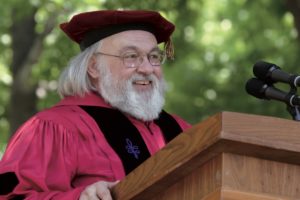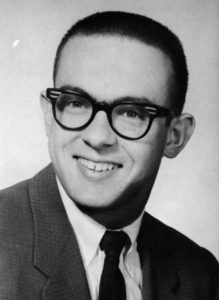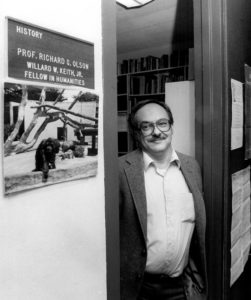
November 4, 1940–June 27, 2020
The Harvey Mudd College community mourns the loss of physicist, historian and Harvey Mudd alumnus Richard G. Olson, who died June 27. Former chair of the faculty and chair of the Department of Humanities, Social Sciences, and the Arts, Olson was a prolific writer with more than 60 published works in the history of science. He served on the Harvey Mudd faculty for 35 years before his retirement in 2011.
Born in Saint Paul, Minnesota, Olson grew up in South Dakota, expecting to be a cabinet maker. No one in his family had pursued a college education, and he hadn’t considered it. While he was in high school, his father was transferred to Walnut Creek, California, and the family relocated. Olson tried to get summer work on a construction site, wasn’t hired, and decided that if he couldn’t build small things, he’d build big ones: he’d become an engineer.
A high school counselor suggested Olson consider the new, “upstart” engineering college in Claremont. (The counselor knew of HMC because the prior year, Walnut Creek student Ken Stevens was admitted to the College’s first class, the Class of 1961). Olson applied to HMC and was invited to join the Class of 1962.
At Harvey Mudd College, Olson soon discovered physics and, during classes with the late professor Duane Roller, he was exposed to the history of physics. The HMC course Science and Man’s Goals first attracted Olson to the topics he was to eventually write about and teach. A National Merit Scholar, he went on to pursue his B.A. in physics, earning honors and becoming valedictorian of his class of 32 peers as well as receiving an NSF fellowship to undertake graduate work in physics.
 The lure of the history of science led Olson to pursue graduate work at Harvard because two physics faculty members there were involved in the field. He earned an M.S. in physics, but he was more fascinated by the history than the physics. As a Harvey Mudd alumnus, he received the first Harvey S. Mudd Memorial Endowment Fund grant established by Wilkens & Devereux, Ltd., of London. This fund, established to assist HMC students, faculty and alumni to undertake travel and research in England and the continent, allowed Olson to pursue research for his dissertation “Sir John Leslie: 1766–1832, A Study of the Pursuit of the Exact Sciences in the Scottish Enlightenment.”
The lure of the history of science led Olson to pursue graduate work at Harvard because two physics faculty members there were involved in the field. He earned an M.S. in physics, but he was more fascinated by the history than the physics. As a Harvey Mudd alumnus, he received the first Harvey S. Mudd Memorial Endowment Fund grant established by Wilkens & Devereux, Ltd., of London. This fund, established to assist HMC students, faculty and alumni to undertake travel and research in England and the continent, allowed Olson to pursue research for his dissertation “Sir John Leslie: 1766–1832, A Study of the Pursuit of the Exact Sciences in the Scottish Enlightenment.”
Before receiving his PhD in the history of science in 1967, Olson taught for two years at Tufts University. He then taught for another nine years at the University of California at Santa Cruz, returning to HMC in 1976 on leave from UCSC. He anticipated staying only two years at HMC as a professor, but decided to stay for good.
His research and teaching focused on the history of science, with a special emphasis on the interactions between the natural sciences and other cultural domains, including those of religion, political ideology, and issues of gender and ethnicity. Olson taught courses in European history, the history of science, and U.S. science policy. In addition, he was director of the Science, Technology, and Society Program at The Claremont Colleges, an interdisciplinary program through which students pursue integrated study of the history, philosophy, and social dimensions of science and technology. While he enjoyed teaching HMC students who came to the College because of its traditional commitment in the humanities and social sciences, Olson also relished the challenge of inspiring more cynical science and engineering students to consider that these other fields have something important to offer them, too. In a 1992 College interview, he remarked, “My background in physics makes me a bit more credible in their eyes.”
Not only was Olson an active and challenging teacher, he was also a prolific writer. A sabbatical break during the 1990–1991 school year allowed him to finish writing The Emergence of the Social Sciences: 1642–1792 (1992), a spin-off of his Science Deified and Science Defied: The Historical Significance of Science in Western Culture: Vol II, 1620–1820. (His Volume I of the series, covering the Bronze Age to c1620, is used as a textbook at a number of institutions.)
 Other books include Science and Scientism in Nineteenth Century Europe (2008), which explores the natural scientific foundations underlying liberalism, socialism, positivism, communism and social Darwinism, and Science and Religion, 1450–1900: From Copernicus to Darwin (2004; Chinese edition, Shandong People’s Press, 2008), which explores the complex, often mutually supportive, interactions between scientific and religious developments in the modern Christian West. The latter is part of a 10-volume series, Greenwood Guides to Science and Religion, which explores the interaction between science and religion in many religious traditions for which he was the general editor. In 2015, Olson offered an analysis of the complex relationships between science and society in Scientism and Technocracy in the Twentieth Century: The Legacy of Scientific Management (2015). He has written or edited numerous other books, articles and reviews, including those on feminist issues in the history of science.
Other books include Science and Scientism in Nineteenth Century Europe (2008), which explores the natural scientific foundations underlying liberalism, socialism, positivism, communism and social Darwinism, and Science and Religion, 1450–1900: From Copernicus to Darwin (2004; Chinese edition, Shandong People’s Press, 2008), which explores the complex, often mutually supportive, interactions between scientific and religious developments in the modern Christian West. The latter is part of a 10-volume series, Greenwood Guides to Science and Religion, which explores the interaction between science and religion in many religious traditions for which he was the general editor. In 2015, Olson offered an analysis of the complex relationships between science and society in Scientism and Technocracy in the Twentieth Century: The Legacy of Scientific Management (2015). He has written or edited numerous other books, articles and reviews, including those on feminist issues in the history of science.
Olson greatly valued being able to alternate between his teaching and writing interests. He found the Department of Humanities, Social Sciences and the Arts a perfect home for him, because, as he once stated, “There are no turf boundaries. Each of us here is completely free to explore a range of interests. It’s liberating.”
He chaired the Department of Humanities, Social Sciences, and the Arts from 1982 to 1985, directed The Claremont Colleges Program on Science, Technology and Society from the early to mid-1990s and served as chair of the faculty from 1998 to 2001. He served as the Hennebach Distinguished Visiting Professor in Humanities at the Colorado School of Mines from 2002 to 2003.
Olson was a member of various diversity committees over the years and provided valuable input to the College’s diversity efforts. In 2005, Olson was awarded the Henry T. Mudd Prize for his efforts in faculty recruitment, supportive leadership in academic initiatives, commitment to diversity and community engagement and for his commitment to students. In 2012, the HMC Alumni Association recognized Olson with a Lifetime Achievement Award.
In a 1992 interview with College staff, Olson said, “I enjoy exploring the broad cultural impacts of science. I don’t want to write only for historians of science, but for literate laypersons with varied interests. People worship or vilify science without a full understanding of its cultural implications. I want them to better understand why they view science the way they do.”
Olson is survived by his wife, Kathy Collins Olson, a brother, Gary C. Olson, and Gary’s wife, Tina. The family requests that remembrances in his honor be made to the Richard G. Olson ’62 Endowed Scholarship Fund at Harvey Mudd College.
—
Read the speech by Dick Olson, delivered in spring 2015 during Presentation Days, in which he highlights the challenge of engaging a liberal arts approach to STEM education at Harvey Mudd College.